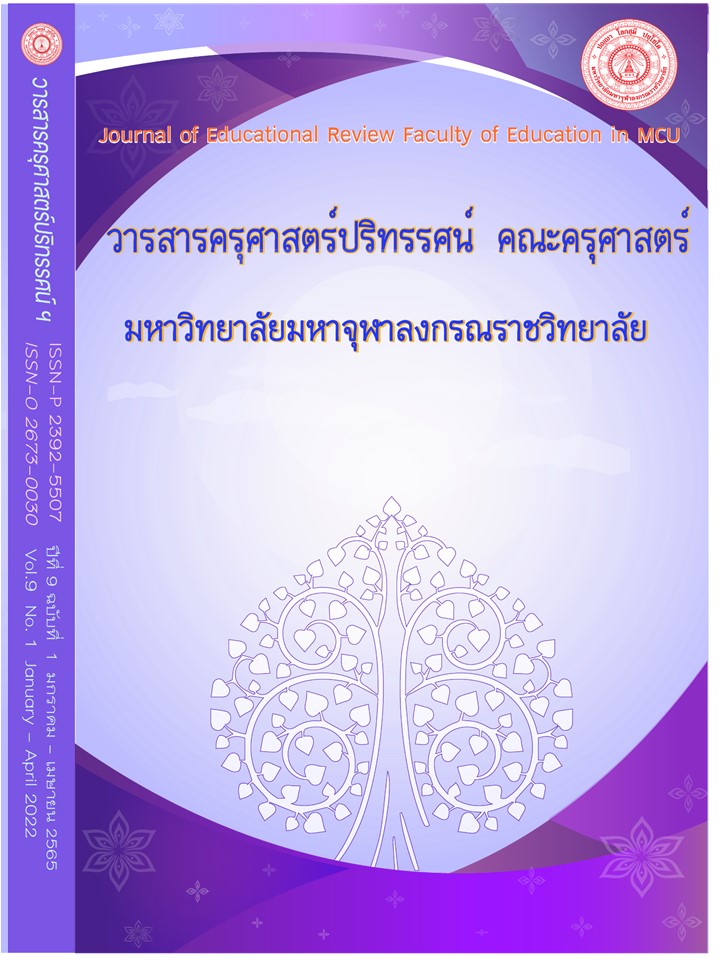แนวทางการพัฒนาแหล่งเรียนรู้ตามหลักพุทธบริหารการศึกษา สำหรับวัดในจังหวัดปทุมธานี
Main Article Content
บทคัดย่อ
บทความวิจัยนี้มีวัตถุประสงค์ 1) เพื่อศึกษาบริบทพื้นฐานและความพร้อมในการจัดการให้เป็นแหล่งเรียนรู้ของวัด 2) เพื่อศึกษาแนวทางการพัฒนาการจัดแหล่งเรียนรู้ภายในวัดตามหลักพุทธบริหารการศึกษา 3) เพื่อเสนอแนวทางพัฒนาแหล่งเรียนรู้ตามหลักพุทธบริหารการศึกษาสำหรับวัดในจังหวัดปทุมธานี ซึ่งเป็นงานวิจัยแบบผสานวิธี คือ 1) การวิจัยเชิงปริมาณ ใช้แบบสอบถามกลุ่มตัวอย่างที่เป็นพระสังฆาธิการ ระดับเจ้าอาวาส จำนวน 123 รูป/คน วิเคราะห์ข้อมูลด้วยสถิติ ได้แก่ ค่าร้อยละ ค่าเฉลี่ย ค่าส่วนเบี่ยงเบนมาตรฐาน ค่าความต้องการจำเป็น 2) การวิจัยเชิงคุณภาพ ด้วยการสัมภาษณ์ผู้ทรงคุณวุฒิ 5 รูป/คน วิเคราะห์ข้อมูลด้วยการวิเคราะห์เนื้อหา ผลการวิจัยพบว่า 1) บริบทพื้นฐานและความพร้อมในการจัดการให้เป็นแหล่งเรียนรู้ของวัดในจังหวัดปทุมธานี มีความต้องการจำเป็นตามลำดับ คือ (1) การประเมินผลและติดตามผลการเรียนรู้ (2) การบริหารจัดการแหล่งเรียนรู้ (3) อุปกรณ์สำหรับการเรียนรู้ (4) ผู้เรียน (5) กิจกรรมที่จะทำให้เกิดการเรียนรู้ (6) วิธีการจัดกระบวนการเรียนรู้ (7) ผู้ดำเนินการให้เกิดกิจกรรมการเรียนรู้ (8) สถานที่เรียนรู้ (9) แหล่งที่มาของความรู้และเนื้อหาความรู้ 2) แนวทางการพัฒนาการจัดแหล่งเรียนรู้ภายในวัดตามหลักพุทธบริหารการศึกษาจะต้องพิจารณาถึงองค์ประกอบที่จะทำให้เป็นแหล่งเรียนรู้โดยยึดหลักสัปปายะ 7 เพื่อให้เกิดความพร้อมในแต่ละด้าน โดยผู้ที่เกี่ยวข้องต้องกำหนดนโยบายที่เป็นรูปธรรมในการพัฒนาและปรับปรุงเพื่อทำงานร่วมกันภายใต้เป้าหมายเดียวกัน และ 3) แนวทางพัฒนาแหล่งเรียนรู้ตามหลักพุทธบริหารการศึกษาสำหรับวัดในจังหวัดปทุมธานี ประกอบด้วยหลักสัปปายะ 7 คือ (1) อาวาสสัปปายะ แหล่งเรียนรู้ควรดูแลความสะอาดและความเป็นระเบียบ (2) โคจรสัปปายะ ควรมีแผนผังของสถานที่ให้ชัดเจน (3) ภัสสสัปปายะ ผู้ดำเนินการให้เกิดกิจกรรมการเรียนรู้สามารถพูดให้ผู้เรียนทำกิจกรรมร่วมกัน (4) ปุคคลสัปปายะ ผู้กำหนดนโยบายผลักดันกิจกรรมให้ขับเคลื่อน (5) โภชนสัปปายะ มีอาหารที่มีความสะอาดมีคุณภาพและเกื้อกูลต่อสุขภาพ 6) อุตุสัปปายะ สภาพแวดล้อมมีอุณหภูมิพอเหมาะและสร้างบรรยากาศในการปฏิบัติกิจกรรมได้นาน และ 7) อิริยาบถสัปปายะ การจัดกิจกรรมที่มีการเคลื่อนไหวเกิดความสมดุลของร่างกาย
Article Details

อนุญาตภายใต้เงื่อนไข Creative Commons Attribution-NonCommercial-NoDerivatives 4.0 International License.
ทัศนะและความคิดเห็นที่ปรากฏในบทความในวารสารฉบับนี้ถือเป็นความรับผิดชอบของผู้เขียนบทความนั้นเพียงผู้เดียว และไม่ถือเป็นทัศนะและความรับผิดชอบของกองบรรณาธิการ
กองบรรณาธิการขอสงวนสิทธิ์ในการคัดเลือกบทความลงตีพิมพ์และจะแจ้งให้เจ้าของบทความทราบหลังจากผู้ประเมินบทความตรวจอ่านบทความแล้ว
ต้นฉบับที่ได้รับการตีพิมพ์ในวารสารครุศาสตร์ปริทรรศน์ คณะครุศาสตร์ มหาวิทยาลัยมหาจุฬาลงกรณราชวิทยาลัย ถือเป็นกรรมสิทธิ์ของคณะครุศาสตร์ มหาวิทยาลัยมหาจุฬาลงกรณราชวิทยาลัย ห้ามนำข้อความทั้งหมดหรือบางส่วนไปพิมพ์ซ้ำ เว้นเสียแต่ว่าจะได้รับอนุญาตจากมหาวิทยาลัยฯ เป็นลายลักษณ์อักษร
เอกสารอ้างอิง
กองพุทธศาสนาสถาน สำนักงานพระพุทธศาสนาแห่งชาติ. (2553). วัดพัฒนา’52. กรุงเทพมหานคร:
โรงพิมพ์สำนักงานพระพุทธศาสนาแห่งชาติ.
ครรชิต พุทธโกษา. (2554). คู่มือการพัฒนาชุมชนแห่งการเรียนรู้ ฉบับสมบูรณ์. แหล่งที่มา http://www.kruinter.com/file/29720141006205700-%5Bkruinter.com%5D.pdf สืบค้นเมื่อ 24 มิ.ย. 2563
ธงชัย สันติวงษ์ และ ชัยยศ สันติวงษ์. (2533). พฤติกรรมบุคคลในองค์การ. พิมพ์ครั้งที่ 2. กรุงเทพมหานคร: ไทยวัฒนาพานิช.
ประพันธ์ศิริ สุเสารัจ. (2540). การพัฒนากีฬาชาติ: การศึกษาประสิทธิผลของสมาคมกีฬาสมัครเล่นแห่งประเทศไทยกับปัจจัยที่เกี่ยวข้อง. ดุษฎีนิพนธ์การศึกษาดุษฎีบัณฑิต. มหาวิทยาลัยศรีนครินทรวิโรฒประสานมิตร.
พระครูวัฒนสุตานุกูล (วีรวัฒน์ ลทฺธคุโณ). (2558). กระบวนการพัฒนาวัดให้เป็นแหล่งการเรียนรู้ของคณะสงฆ์ไทย. ดุษฎีนิพนธ์พุทธศาสตรดุษฎีบัณฑิต. มหาวิทยามหาจุฬาลงกรณราชวิทยาลัย.
พระครูสังฆรักษ์วุฒิพงษ์ วุฑฒิวํโส. (2560). การพัฒนาวัดในประเทศไทยเป็นแหล่งเรียนรู้เชิงพุทธเพื่อส่งเสริมการท่องเที่ยวอาเซียน. ดุษฎีนิพนธ์พุทธศาสตรดุษฎีบัณฑิต. มหาวิทยามหาจุฬาลงกรณราชวิทยาลัย.
พระราชวรมุนี (ประยุทธ์ ปยุตฺโต). (2530). บทบาทของพระสงฆ์ในสังคมไทยปัจจุบัน, หนังสือชุดหลักธรรมเฉลิมพระเกียรติ เล่ม 54/60, กรุงเทพฯ : โรงพิมพ์การศาสนา.
สนิท ศรีสำแดง. (2547). พุทธศาสนากับการศึกษา. กรุงเทพมหานคร: โรงพิมพ์มหาจุฬาลงกรณราชวิทยาลัย.
สุภางค์ จันทวานิช. (2540). วิธีวิจัยเชิงคุณภาพ. กรุงเทพมหานคร: โรงพิมพ์มหาจุฬาลงกรณราชวิทยาลัย.
สุวิมล ว่องวาณิช. (2558). การวิจัยประเมินความต้องการจำเป็น. กรุงเทพมหานคร: สำนักพิมพ์แห่งจุฬาลงกรณ์มหาวิทยาลัย.
อานนท์ อาภาภิรมย์. (2521). สังคมและวัฒนธรรมไทย. กรุงเทพมหานคร: บำรุงนุกูลกิจการพิมพ์.
Peters T. and Waterman R. (1982). In Search of Excellence; Lessons From America's Best Run Companies. New York: Harper & Row.


